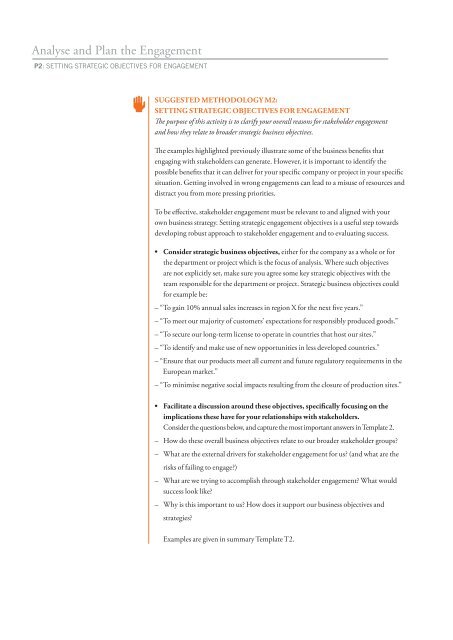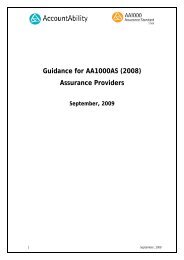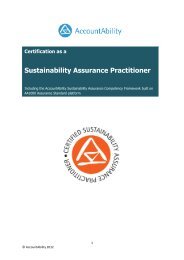The Stakeholder Engagement Manual Volume 2 - AccountAbility
The Stakeholder Engagement Manual Volume 2 - AccountAbility
The Stakeholder Engagement Manual Volume 2 - AccountAbility
Create successful ePaper yourself
Turn your PDF publications into a flip-book with our unique Google optimized e-Paper software.
Analyse and Plan the <strong>Engagement</strong><br />
P2: SETTING STRATEGIC OBJECTIVES FOR ENGAGEMENT<br />
SUGGESTED METHODOLOGY M2:<br />
SETTING STRATEGIC OBJECTIVES FOR ENGAGEMENT<br />
Th e purpose of this activity is to clarify your overall reasons for stakeholder engagement<br />
and how they relate to broader strategic business objectives.<br />
Th e examples highlighted previously illustrate some of the business benefi ts that<br />
engaging with stakeholders can generate. However, it is important to identify the<br />
possible benefi ts that it can deliver for your specifi c company or project in your specifi c<br />
situation. Getting involved in wrong engagements can lead to a misuse of resources and<br />
distract you from more pressing priorities.<br />
To be eff ective, stakeholder engagement must be relevant to and aligned with your<br />
own business strategy. Setting strategic engagement objectives is a useful step towards<br />
developing robust approach to stakeholder engagement and to evaluating success.<br />
• Consider strategic business objectives, either for the company as a whole or for<br />
the department or project which is the focus of analysis. Where such objectives<br />
are not explicitly set, make sure you agree some key strategic objectives with the<br />
team responsible for the department or project. Strategic business objectives could<br />
for example be:<br />
– “To gain 10% annual sales increases in region X for the next fi ve years.”<br />
– “To meet our majority of customers’ expectations for responsibly produced goods.”<br />
– “To secure our long-term license to operate in countries that host our sites.”<br />
– “To identify and make use of new opportunities in less developed countries.”<br />
– “ Ensure that our products meet all current and future regulatory requirements in the<br />
European market.”<br />
– “To minimise negative social impacts resulting from the closure of production sites.”<br />
• Facilitate a discussion around these objectives, specifi cally focusing on the<br />
implications these have for your relationships with stakeholders.<br />
Consider the questions below, and capture the most important answers in Template 2.<br />
– How do these overall business objectives relate to our broader stakeholder groups?<br />
– What are the external drivers for stakeholder engagement for us? (and what are the<br />
risks of failing to engage?)<br />
– What are we trying to accomplish through stakeholder engagement? What would<br />
success look like?<br />
– Why is this important to us? How does it support our business objectives and<br />
strategies?<br />
Examples are given in summary Template T2.

















